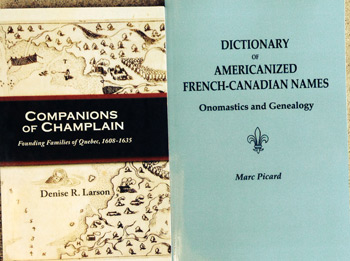
|
|
|
| Product Information: | ||
| Details: | The following two popular French-Canadian related books are bundled at a special price. The books are: Dictionary of Americanized French-Canadian Names: Onomastics and Genealogy; by Marc Picard; xviii + 170 pp; Paper; Published: 2013; ISBN: 9780806356457; Item # CF8465DName expert Marc Picard’s latest book is must reading for anyone with French-Canadian ancestry (or for institutions serving such a population). Monsieur Picard, who has previously written about the etymologies of the French migrants who settled Quebec and Acadia in the 17th and 18th centuries, now follows the spread of those surnames to various English-speaking parts of North America in his Dictionary of Americanized French-Canadian Names. Besides its derivations and Anglicizations, this terrific resource references the first French-Canadian settlers bearing the names found in the dictionary. Professor Picard explains the development of French-Canadian surnames and their subsequent "Americanization" in his twelve-page Introduction, which, among other things, discusses various kinds of Anglicization, direct translations, partial translation, and mistranslations of French into English. For instance, did you know that Americans named Blair may have inherited their surname from a Canadian named Belair (one of several place-names in France); that the Americanized "Bushey" comes from Boissy; or that Greenwood may have originally been Boisvert? Similarly, while On the Road author, Jack Kerouac, retained his French surname, persons with the American version "Curwick" may have the same ancestors. The last name of former Dallas Cowboys coach Tom Landry comes directly from the French; however, that surname also shows up in the U.S. as Landrey, Landrie, Laundra, Laundre, Laundrie, Laundry, Londeree, Londrie, and Londry. And some Americanizations are phonetically predictable, as in Maurice/Morris, Meilleur/Miller; or Sylvestre/Sylvester; others, however, are less so, as in "Sharkey" from Chartier, Butler from Breton, or Wells from Dupuis. Each of the thousands of entries in the Dictionary of Americanized French-Canadian Names contains two parts. The first of these is onomastic in nature, providing the etymology of the surname and any Americanized variants from which they stem. The second part contains some or all of the following information: the name of the first French-Canadian bearer of the name, the name of his parents, his place of origin in France, the name of his spouse and the names of her parents, and the place of his marriage. In addition to the Introduction and the dictionary itself, readers will find a brief list of abbreviations used throughout the text and a detailed bibliography of sources. ____________________________________Companions of Champlain: Founding Families of Quebec, 1608-1635; by Denise Larson; x + 179 pp; Paper; 5.5x8.5; Published: 2008, Reprinted: 2009; ISBN: 9780806353678; Item # CF9914DDrawing on primary and reliable secondary sources, this work provides readers with a concise historical overview of the founding of Quebec and French-Canadian culture. It also supplies readers with the research tools necessary to link their family lines with those of the original 18 pioneer families who inhabited Quebec during the lifetime of the city's founder, Samuel de Champlain. Companions of Champlain was produced to honor the 400th anniversary of the founding of Quebec City and to enable North Americans on both sides of the border to appreciate more fully their French-Canadian heritage. Companions of Champlain explains in clear language the reasons for the New-World explorations of Samuel de Champlain in the 1600s and the unique culture that resulted from the establishment of a trading post in the wilds of North America in 1608. It is the story of the habitant family-the farm and daily life-not the complex intrigues of the French king and court, though some historical background information is included. The historical backdrop for Companions of Champlain was drawn from the few extant primary sources of the early 17th century, most particularly Champlain's Voyages, Marc Lescarbot's Nova Francia and Jesuit Relations, and standard references such as H. P. Biggar's Works of Samuel de Champlain and Gustave Lanctot's A History of Canada. Although Champlain and his wife, Helene Boulle, did not have children, his companions did. The original 18 pioneer families who inhabited Quebec during Champlain's lifetime formed the nucleus of French-Canadian culture from which a new society sprang. They are the focal point of this work. The author traces the genealogy for three generations of the following 18 founding families: Amiot/Amyot, Boucher, Bourdon, Cloutier, Cote/Coste, Couillard/Couillart, Delaunay, Desportes, Giffard, Guyon, Hebert (Quebec's first colonial family, Hebert, is followed through five generations), Juchereau, Langlois, Marsolet, Martin, Nicolet, Pinguet, and Tardif/Letardif. The author also presents a methodology by which readers can trace their lineage in a quest to link with one of Quebec's founding families. Genealogical chart information was extracted from documents and records held at the Archives nationales du Quebec; in city, state, parochial, and provincial offices; and from reliable secondary sources, such as the genealogical dictionaries of Cyprien Tanguay and Rene Jette. Other important features of this groundbreaking work include maps, an illustration of Champlain's 1603 astrolabe, references, five appendices, lineage and pedigree charts with citations, and a comprehensive index. Appendices provide a glossary of French genealogical terminology and an example of citation notation for use when filling in ancestral charts, one of which is provided for reproduction. The full-reference citation method described in the book is unique in that it is keyed from the numbering sequence on commonly used charts and does not require the superscripts and complex systems often found in genealogy. |
|

